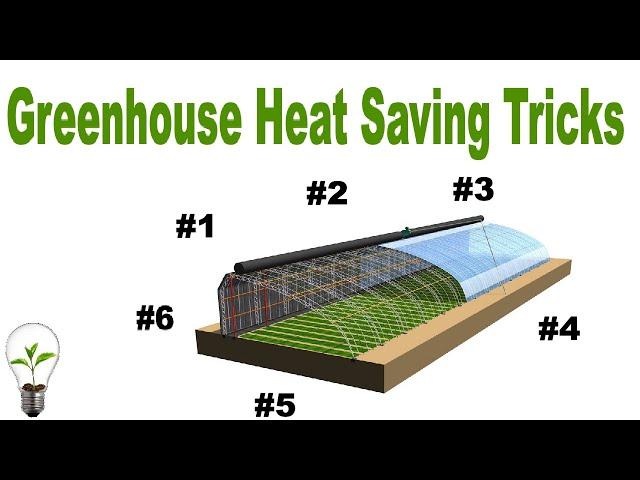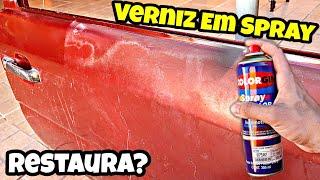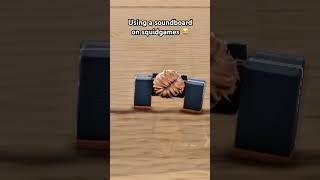
6 Ways to Insulate or Store Heat in a Greenhouse
Комментарии:

Always love seeing your videos about greenhouses!
One day I'd really want to work with you building a great greenhouse.
Thanks for the video!

I get around heat loss by having built my greenhouse alongside my steel-walled dwelling, which acts as a thermal mass somewhat. The floor is slab on grade. The exhaust from my house's gas wall furnace runs through the length of the greenhouse, so when I heat my house, I heat my greenhouse at the same time. Also, my electricity plan affords me free electricity at night, so I can run a small ceramic heater on a timer those times I'm not home. I have been considering installing a bypass on the wall furnace vent, which would spill CO2-rich exhaust from the burned propane gas used to heat my house, but haven't gotten around to it yet. I grow mostly leafy greens and herbs in North Texas.
Ответить
thank you!
Ответить
My brother, most excellent pre-flood plug I’ve ever heard! Keep up the great work, I love your videos! Thank you so much for your time and experience.
Ответить
I was talking to a Lady who sold dried Apple chips and fruit roll-ups at a Farmers Market .She said she had a greenhouse and heated it with 2 vegetable and fruit driers. . in the greenhouse .
Ответить
We have a farmer who lives west of us who uses geothermal air exchanger to help regulate the air temperature. Allows for year round usage of his green house.
Ответить
my greenhouse will face north
Ответить
Hi, could you use used double glazed panes from house windows being replaced? I understand some home windows are treated to prevent too much sunlight coming into a room.
Ответить
Here in Germany I compost horse manure with straw inside a greenhouse to keep the plants warm. This technique is shown in gardening videos from Europe.
Gardening companies here sell big black hoses with water inside to put on the ground of the greenhouse. The sun warms up the water in the black water vessels.

Putting black water filled cylinders between plants or in front of the north wall should help, too.
Ответить
'radiating cold ---' doesn't happen; not good physics talk. Similar to saying that 'hot' air sucks cold air up a chimney. Better to say that cold air pushes warm air up a chimney. (The word draft is inappropriate )
Ответить
At what parallel would you guess it is time to switch from clear sides to insulated sides?
Ответить
I’m battling my husband on putting our green house backing one of our many hillsides, with plans to bore or drill holes to use the earth heat/cooling.
Having twice as much vertical land than horizontal we have options. 😊

In northern areas of China, they will make a blanket using corn stalks that roll up and down at night.
Have a great day!

Yay. Simple Tek in the "green" house!
Ответить
COLOR is important
Limestone WHITE has a tendency to stay a few degrees BELOW ambient air temperature
Black has a tendency to absorb heat and stay above ambient air temperature
add DARK pigment to the concrete mix of any thermal mass you want to retain heat in and do not add pigment if you want to radiate heat (more southern climates)
so end walls black on the outside to absorb heat and white on the inside to radiate it
a reflective layer on the quilting to help reflect any heat instead of letting it radiate is a bonus

How low would the soil temperature need to go for heated floor to make sense? Thanks for the video.
Ответить
You always do something interesting!
Ответить
why not calculate how much animal life you could use for CO2 offset inside the greenhouse? Perhaps things like rabbit hutches or guinea pigs along the thermal mass wall. 😁 edit: oh and manure for hot composting!
Ответить
In northern wintertime it makes sense to have plants growing in the home placed with southern exposure in a super (wood fiber) insulated house equipped with insulated shutters.
Ответить
Another way to store heat is called a climate battery. It consists of an air tube to collect warm air from the top of the greenhouse and duct the air through tubes burrowed under the grow beds. And covering the plants with floating row covers, insulation for just the plants. That's it in its simplest form. It can get more complex.
Small fans to move air /co2 in contact with leaf surface. Black plastic coils set in the sun to preheat water used to water plants.
My latest, lean-to style, micro-greenhouse has concrete pavers and will share a window with the house. A thermostat controlled fan will move the extra heat. Cheap moving blankets as movable insulation. Instead of the 2d layer of plastic.
Just a few ideas.

also having mamals inside can help with both CO2 in morning and heating at night but for night maybe in diffrent part with out air circulances only heat can transfer "spreated by a metal sheet wall.".
Ответить
My dream greenhouse would start with insulation with 2 ft of gravel on top then with air tubes. Then concrete floor with hydronic pex floor heat. Id attached onto my entire Southside of my home.
Ответить
What do you think about "cold paths"?
Ответить
This is helpful for many!
In regards to insulating/storing heat, I really the idea to leverage radiant heat down low, so I like the pex/sidewalk paver idea. I'll be doing a Rocket Mass Heater myself.
The second thing I wonder about is the blanket. It seems like a great idea, but I think doing only a small section makes sense in most <4-season applications. I've been playing around with the idea of setting poles/pipe to be able to heavily blanket <20% the volume of the greenhouse, and radiant heat/thermal mass that section.
Also curious about the value of ambient sunlight(north wall). I bet its hard to find studies/research. I got the sense from a vergepermaculture interview that ambient light from north wall has some value, maybe even more so than +1R-value.

Looking to build a greenhouse in northern Illinois and the north wall with an east-west orientation seems to make sense. Trying to decide what materials to build the north wall. Current though is an insulated framed wall with a thermal mass lining the inside. I have also seen a design that uses a huge compost pile as a heat source and air tubes underneath that capture the heat and pump that into the green house. Any thoughts?
Ответить
Thermal banking. Transfer heated air from the day or from all summer and pull from that solar bank all winter. Heat pump system using water or air should easily transfer this heat to and from your solar bank.
Solar bank is typically the soil under the green house. Raising the ground temperature from an average of 14 Celsius degrees at 8 feet below grade to an average 18 degrees Celsius.
I have yet to build my wallipini. Or one glazed wall/ceiling, 4 walls half under ground, like the Chinese green houses in this video, except 4ft buried walls

I was thinking of using one of those orange, thick, insulating tarps that they use for concrete construction to use as a thermal blanket. It should last a long time and is light enough for me to handle. Not very expensive either.
Ответить
i looked into greenhouse blankets, and couldn't find any instruction or product that worked for a typical gothic cold frame greenhouse (i.e. a frame without a northern wall, like a Chinese passive solar gh). Most blankets I found came in 4-5' widths and were only shown being used on Chinese passive solars.
What's a guy to do with a typical gothic frame who wants to use a greenhouse blanket?

I love you videos and content. Can we get a smaller talking head maybe in the corner.
Ответить
for a cheap fruitful co2 generator put a couple of mushroom logs in the green house. Fungi breath o2 and produce co2, but they must be shade so put them under a workbench or something
Ответить
add a mushroom cultivation room and pump CO2 from that room into greenhouse. and oxygen enriched air into mushroom grow room.
Ответить
also put heat exchage unit in shroom room to usefully dispel the heat generated during fruiting.
Ответить
a truly symbiotic relationship.
Ответить
nonsense
Ответить
why u don't research before posting video?
Ответить
Thanks for the video. I would like to build a dome greenhouse and work area
What size of. Conduit Thanks

Thanks! I was just gifted a wooden greenhouse. I'm in Northern Wisconsin...so it is wooden on 3 sides and waist high on the side with glass windows. It has a long black shingled roof pointing north with a back wall of about 6 ft tall. The walls are 2 x 4 studs with decorative plywood on the outside. We poured a concrete slab and fastened it down. After watching your video I have a few questions. Would it help to paint the inside flat black? What type of insulation is safe for me and the plants for the side walls? What type of wall material is safe? As a starter I'd like to use it for 3 seasons....not sure how it will work....but it's faster ed down on a slab and I painted it to match our house....so it's a family member now😂 any advice would be welcomed!
Ответить
Have you disabled saving a link to the Library?
Ответить
Isolating the ground under the greenhouse up to 8ft deep is probably a better solution than simply isolating the floor. This would allow to benefit from the stable energy (temperature) of the ground under 6ft. This action would keep the temperature of the ground above 5C during winter which would be great for winter production. But is that action would be sufficient to also keep the greenhouse air above the freezing point? or would we need a geothermal system Air-ground to ensure to maintain the air above the freezing point? Nevertheless, a geothermal system might be interesting to be used as an air conditionner during hot period, what do you think? What is the best?
Ответить
You dont need a fan to create airgap between double poly plastic walls. In old days it was done using 3 nolon strings in each wall element. Fans came in 1980s. I might bee old fasioned but I will go with the old method for my greenhouse next summer as the fan only adds electricity costs.
Ответить
Wow this is great. New sub! I plan to build my first greenhouse later this year. I'm hoping to eventually replace my job with farming over the next 5-10 years. I've got 1.5 acres to work with right now, but I'm neighbored by my ageing parents with 20 acres that nets Zero. If I can make 1.5 work, I can expand. Just need proof of concept
Ответить
Are you saying Carbon Dioxide in the air makes plants bigger? Hmmmmmmm. Never heard that on TV before.
Ответить

























